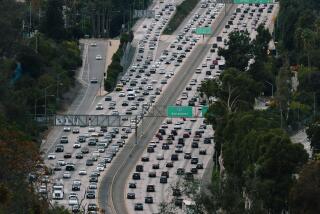Blocked 60 Freeway doubles and triples drivers’ commute times
- Share via
With patience, frustration and a lot of help from their GPS devices, L.A. commuters faced down a true “carmageddon” as a spectacular tanker truck explosion kept a key freeway closed and turned the already tough Christmastime traffic into an endurance contest.
Commutes between eastern suburbs and Los Angeles that once took half an hour doubled and tripled as other freeways and surface streets clogged for miles.
When the 60 Freeway — which normally carries about 225,000 cars daily — closed Wednesday afternoon, it took Patty Ortega three hours to get home to North Whittier after she made the fateful choice to take Beverly Boulevard and Olympic Boulevard.
“The light would turn green and nobody would move,” said Ortega, a legal assistant who works in Century City.” We were stuck because it was so backed up.”
On Thursday, she studied the traffic conditions carefully and picked a more circuitous but faster route that still doubled her normal commute time. Like many drivers, she had one word for the situation: “Nightmare.”
While commuters struggled to get around the blocked stretch of freeway, engineers were at the Paramount Boulevard bridge above the 60 assessing the damage and promising to reopen the artery no later than 5 p.m. Friday. They quickly realized that at least half the bridge — the section burned by flames from the tanker — had to be torn down.
Even hours after the fire was extinguished, the bridge felt hot. “It was still warm,” said California Department of Transportation spokesman Patrick Chandler. “Concrete retains heat for a long time. You could walk under the bridge and it was 15 degrees warmer.”
The tanker started burning while traveling east Wednesday around noon, and the driver abandoned it at the bridge shortly before it exploded in a fireball. The blaze burned for several hours, fueled by 8,800 gallons of gasoline. Authorities don’t yet know what sparked the fire but are inspecting the truck to determine whether faulty brakes played a role.
The blaze was so intense that “the flames caused the cement above to pop and become brittle and fall to the roadway,” Chandler said.
Engineers determined that reinforcing steel on the southern side of the bridge was compromised because the outer layers of concrete popped off.
Caltrans was working around the clock to remove the damaged parts of the bridge, including the abutment to the columns that support the structure. Workers laid gravel on the freeway to catch chunks of concrete so the impact would not further harm the road surface.
“Time is money,” Chandler said. “The quicker we get this done, the quicker we can get the freeway opened.”
Experts said a hot fire can significantly weaken a freeway bridge.
Thomas Sabol, an adjunct professor of engineering at UCLA, said when concrete is exposed to high heat, it expands. The outer layer of the concrete may separate from the mass of the bridge, exposing the reinforcing steel, which is a critical part of the structure.
“When the steel is exposed to high temperatures, it begins to lose strength, and when it loses strength, that in turn can compromise the structural integrity of the bridge itself,” he said.
Officials said the freeway would reopen as early as noon Friday, but stressed that they were trying to determine whether the other side of the bridge over the westbound lanes needed to be demolished.
The overpass, built in 1967, was in good condition, with a federal “sufficiency rating” of 87 out of 100 measuring its fitness to remain in operation, based on structural integrity and other factors. But it is also considered functionally obsolete because it is too narrow for the traffic it now serves. It’s unclear whether the design will change. Either way, rebuilding the overpass is expected to take months.
The situation is similar to the scheduled bridge demolition that closed the 405 Freeway in the Sepulveda Pass in July. Officials worried about major gridlock, and the closure became known as “Carmageddon.”
The traffic nightmares never materialized, largely because all the publicity scared drivers off the road that weekend. But the 60 closure, happening without warning during on a weekday, was a different story.
“This is worse than Carmageddon,” said Jonathan Slaughter, 27, who endured a 1 1/2-hour drive from his home in Palms to his consulting job in Irwindale. Slaughter took a route recommended by an app on his iPhone, but the traffic was much worse than the computer predicted. “I never realized how critical a main freeway is,” he said.
The 60 is a major east-west route between downtown and the San Gabriel Valley and Riverside. It is also a well-traveled truck route for cargo headed from the ports of L.A. and Long Beach to the Inland Empire. But unlike the 405 through the Sepulveda Pass, the 60 has numerous alternate routes, including the 10 and 210 Freeways, as well as many surface streets like Whittier and Valley boulevards.
Experts said these routes offered some cushion for what could have been a much worse situation on a more isolated freeway.
The California Highway Patrol urged commuters to use public transportation or work from home. Metro reported a slight increase in ridership on the East L.A. Gold Line, but most people appeared to brave the roads.
Elijah Quesada, 25, left his Hacienda Heights home at 6 a.m. Thursday for his drive to Vernon. Using GPS and “knowledge of the streets,” Quesada said he made surprisingly good time — and was proud of himself.
“We live in L.A.,” he said. “We live in traffic. You have to learn to work around it.”
Los Angeles Times staff writers Ari Bloomekatz and Dalina Castellanos contributed to this report.
More to Read
Sign up for Essential California
The most important California stories and recommendations in your inbox every morning.
You may occasionally receive promotional content from the Los Angeles Times.











